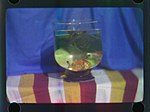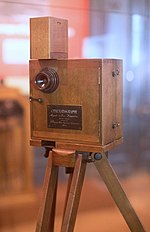In bipack color photography for motion pictures, two strips of black-and-white 35 mm film, running through the camera emulsion to emulsion, are used to...
5 KB (724 words) - 16:24, 24 September 2023
In cinematography, bipacking, or a bipack, is the process of loading two reels of film into a camera, so that they both pass through the camera gate together...
7 KB (979 words) - 17:06, 21 March 2024
This was done, according to Scorsese, to emulate the look of early bipack color films, in particular the Multicolor process, which Hughes himself owned...
48 KB (4,974 words) - 18:05, 15 September 2024
invention of Prizma led to a series of similarly printed color processes. This bipack color system used two strips of film running through the camera...
45 KB (6,202 words) - 22:13, 26 August 2024
Cinecolor (redirect from Color Corporation of America)
Gundelfinger, and its various formats were in use from 1932 to 1955. As a bipack color process, the photographer loaded a standard camera with two film stocks:...
17 KB (2,283 words) - 13:34, 24 September 2024
bipack processes a viable option for color portraiture. In commercial practice, however, the use of bipacks was almost entirely confined to two-color...
62 KB (8,594 words) - 00:23, 3 October 2024
camera capable of bipacking film. Two black-and-white 35mm film negatives are threaded bipack in the camera. One records the color red (via a dyed panchromatic...
4 KB (424 words) - 00:19, 23 August 2023
Bicolor (redirect from Bi-color (disambiguation))
of biological species Two Colours (disambiguation) Bipack color, an early method of filming in color This disambiguation page lists articles associated...
535 bytes (124 words) - 09:41, 27 October 2020
films listed were release printed from three (including those in bipack Technichrome) color matrices in Technicolor's dye-transfer process in either Hollywood...
121 KB (633 words) - 09:10, 28 June 2024
This is a list of color film processes known to have been created for photographing and exhibiting motion pictures in color since the first attempts were...
13 KB (458 words) - 17:38, 9 February 2024
Kodachrome (redirect from Two-Color Kodachrome Test Shots No. III)
emulsion insensitive to red light. The two plates could be exposed as a "bipack" (sandwiched emulsion to emulsion, with a very thin red filter layer between)...
54 KB (5,387 words) - 03:55, 26 September 2024
1890 – 19 June 1987) was the inventor of a bipack process, which allowed any cinematic camera to shoot color film. In 1932 he developed Cinecolor. He was...
1 KB (103 words) - 20:44, 15 June 2021
as Cinecolor did not offer three-color origination, only two-color origination via bipack. On their way to their jobs at the Death's Head Tavern, Oliver...
6 KB (733 words) - 02:54, 30 September 2024
the colors of the spectrum are contained on one film - its opposite is bipack colour film where two films face each other and the lower spectrum reds...
2 KB (263 words) - 08:27, 19 October 2023
1920s they could not compete with rival bipack and other subtractive color processes, which were free of color flicker and did not require special projection...
15 KB (1,925 words) - 00:44, 11 April 2024
35 mm movie film (section Color)
system of two-color bipack photography and two-sided prints was the basis for many later color processes, such as Multicolor, Brewster Color and Cinecolor...
64 KB (7,977 words) - 06:00, 14 September 2024
exposure over the latent live action scenes from occurring. To begin a bipack matte filming, the live action portion is shot. The film is loaded and projected...
24 KB (3,591 words) - 23:03, 10 September 2024
History of film technology (section Color films)
split into two paths to expose three black-and-white films (two of them in bipack), one each to record the densities for red, green and blue. The three negatives...
94 KB (11,975 words) - 01:37, 7 September 2024
South Carolina, in the summer of 1999. After shooting tests, including film bipack and bleach bypass techniques, Deakins suggested digital mastering be used...
57 KB (4,821 words) - 17:15, 13 September 2024
negatives photographed through red and blue-green filters, or by an equivalent bipack method, were photographically printed onto opposite sides of the duplitized...
2 KB (330 words) - 21:41, 26 March 2024
Sairandhri (1933 film) (category 1930s color films)
on Agfa B&W 35-mm negative. The release prints were made in Germany by Bipack colour printing process. The film revolved around an incident from the Mahabharata...
8 KB (720 words) - 03:04, 6 July 2024
William Van Doren Kelley's Prizma color process. Trucolor films were shot in bipack, with the two strips of film being sensitized to red and blue. Both negatives...
9 KB (1,163 words) - 22:21, 31 October 2023
scene where Kong pushes the gates open. The Williams process did not use bipacking, but rather an optical printer, the first such device that synchronized...
60 KB (6,756 words) - 04:49, 30 September 2024









